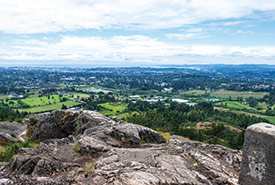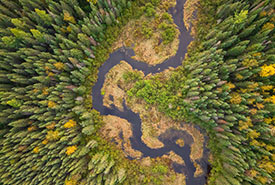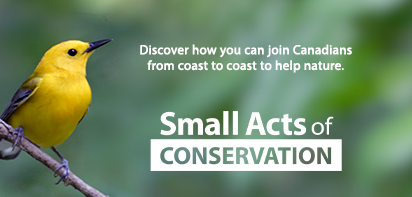At the forefront

Photo by Getty Images
By Jimmy Thomson, journalist and journalism teacher
Using bold thinking, innovative approaches and new technologies to accelerate conservation.
The wind is pummelling the top of PKOLS as I reach the summit, trailing behind the Nature Conservancy of Canada’s (NCC’s) science and research director, Aerin Jacob.
It’s a rare day of extreme wind on the southern tip of Vancouver Island; a day when the ocean below seems bent on overtaking the shoreline, and the occasional drops of rain, even up here, taste every bit as salty as sea spray as the coastline’s discrete parts blend together in the maelstrom. The squat hill, also known as Mount Douglas but now increasingly recognized by its original name in the local SENĆOŦEN language, may feel like a high mountain peak on a day like this, but it’s only 225 metres high. Still, this municipal park provides a stellar vantage point from which to see the blurry lines delineating the landscape below: farmland that bleeds into golf courses; leafy residential streets that disappear into parks; and in the middle distance, the dense tangle of the provincial capital, which itself falls off at jagged edges into the ocean.
![]()
![]()
![]()
If this landscape was a mosaic made up of individual tiles, Jacob explains, each tile would have its own role to play in the region’s ecology. Here on PKOLS, a bald eagle makes use of the wind to ride a little higher above the bending Garry oaks. The oaks themselves are draped in lichens like tinsel — a sign of good air quality, I’m told — and further down the slope, grand old cedar and Douglas-fir trees shade moist soil and streams. It’s the very picture of an urban protected area. By contrast, it’s tempting to think of the farmland and residential areas on the plain below as sacrifice zones, less important to the goals of conservation — but that would be a flawed assumption that doesn’t encompass how nature works and what biodiversity and people need.
“We know that the number and severity of threats facing nature and the pace of change are expanding rapidly. We have to learn from and expand on tried-and-true approaches, like securing and stewarding private land,” Jacob says. “We need to make transformational changes at landscape scales, changes that help nature and people, now and years from now. We need to think big and embrace innovation.” When unprecedented biodiversity decline and climate change are ripping at the interwoven fabric of ecosystems everywhere, Jacob argues, it’s not enough to do what we can and hope for the best.

Terres boréales, Ont. (Photo de Adam Bialo, Kontakt)
Big, ambitious goals, like NCC’s determination to double support in the next three years and double its impact by 2030, demand a bold approach — where no method is taken for granted, and neither successes nor failures go unanalyzed. New tools are needed: financial tools that attract private sector investment to conserve nature, next-generation technologies to make smarter use of data, and planning technology that tracks, understands and communicates changes on each of those little tiles spread out below us, but on a national scale. A bird’s-eye view can help shrug off modes of thinking that risk falling short of the transformative conservation outcomes that are needed.
As an example, Jacob explains that she’s working on new ecological connectivity research that will evaluate the linkages between protected areas across Canada. The project will show how each protected area contributes to overall connectedness, and how the network as a whole can be enhanced by new conserved areas or restoration. “We have to speed up conservation and make it stronger. We need to get much better, more specific, at understanding what works, in which places, and for whom,” Jacob says. “And the best ways you can do that are to be open to new collaborations and ideas, try new things and test them to see if they're working as intended.”
All of it — the bold thinking, the innovative approaches, the new technologies — needs to be brought to bear in the light of day so that people understand what’s happening to nature around them and why.
Digital impact
The point where conservation enters the digital era is Richard Schuster’s wheelhouse. Schuster is NCC’s director of spatial planning and innovation, having made the jump from academia after growing excited about the possibilities for putting his ideas into action.
The Conservation Technology Project he’s heading up is working to create decision-support tools that can help governments and organizations make better-informed choices about how to use land. “We need to be more strategic about where we work and what we do,” he says. That means doing more with what we have — information and land, naturally, but also community buy-in. Good intentions and strong policy don’t amount to much when the policies are ultimately rejected by confused and upset stakeholders. Thanks to the project, real-time discussions can happen with actual data and analysis.
This excerpt originally appeared in the summer 2023 issue of the Nature Conservancy of Canada Magazine.
Explore additional content from our summer issue here >
The Nature Conservancy of Canada Magazine is distributed to NCC donors and supporters who contribute $100 or more per year.



